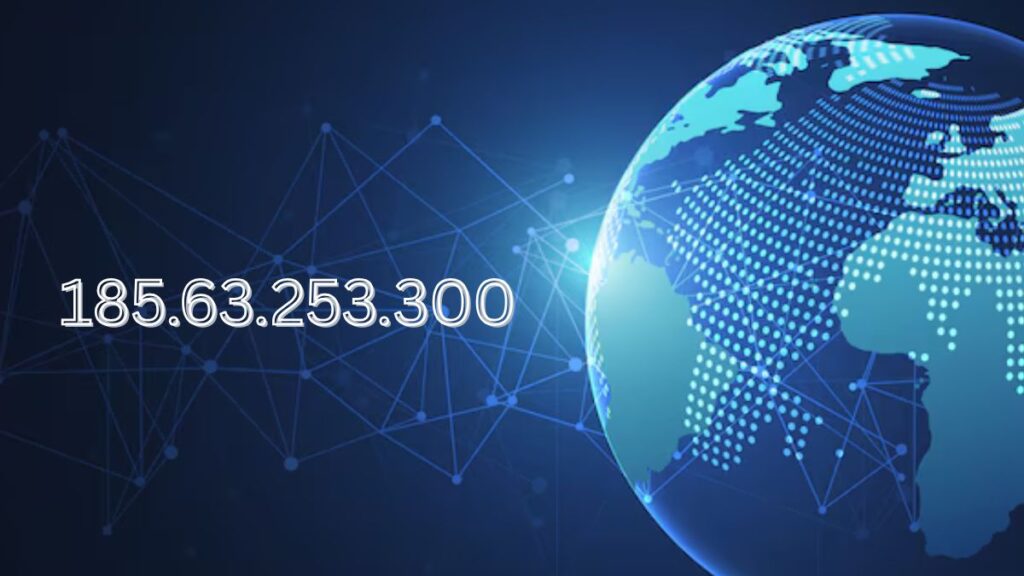In the vast, humming expanse of the internet, every machine speaks in numbers. These numerical dialects—IP addresses—are the fundamental identifiers enabling devices to locate and converse with one another across ethereal fiber-optic highways. Yet, sometimes, a peculiar string arises that piques our curiosity, as if masquerading between realms: 185.63.253.300. On its face, this looks like a standard IPv4 address—four octets separated by dots—but on closer inspection, one digit rebels against protocol: the number “300.” Therein lies the intrigue. Let’s embark on a journey through network fundamentals, digital geography, and the unexpected tale of 185.63.253.300—an address that both exists in our lore and serves as a mirror reflecting the edge cases, errors, and dreams of tomorrow’s internet.
1. IP Addresses 101: Numbers That Speak
Before we sift through the particular oddity of 185.63.253.300, we must first understand the language of IP.
-
The IPv4 Blueprint
Internet Protocol version 4 (IPv4) uses a 32-bit number, typically expressed as four decimal “octets” ranging from 0 to 255. For example,192.168.1.1is an IPv4 address. Each segment (octet) corresponds to 8 bits, so the highest decimal value is 2⁸–1, or 255. -
Public vs. Private
Addresses like10.x.x.x,172.16.x.x–172.31.x.x, and192.168.x.xare private—reserved for internal networks, hidden behind routers. Anything outside those ranges is public, reachable across the internet’s grand tapestry. -
Beyond 255: An Impossible Range
That’s why when we encounter 185.63.253.300, eyebrows raise. The third octet253is valid;63and185fit comfortably. But300? It surpasses the IPv4 ceiling.
Yet, the error is more than a typo; it embodies the ways in which our digital infrastructures handle—and sometimes mishandle—unexpected input.
2. The Anatomy of an Error: What Happens at “.300”?
When you input 185.63.253.300 into network tools or browsers, several scenarios can unfold:
-
Immediate Rejection
Many parsers will flag the address as syntactically invalid, refusing to translate it into binary. -
Octet Wrapping
Some lenient systems apply modular arithmetic: 300 mod 256 = 44. Thus, 185.63.253.300 becomes185.63.253.44. Beneath the hood, the system takes300–256 = 44. This silent correction can lead to unexpected connections—sometimes benign, other times perilous. -
Legacy Interpretation
Older UNIX network utilities once supported unconventional notations: a single 32-bit decimal (e.g.,3232235777) represented192.168.1.1. Similarly, mixing octal or hexadecimal forms sometimes tricked parsers. But a pure decimal octet ≥256 typically breaks standards.
Through these behaviors, 185.63.253.300 is a stress test—revealing how networks sanitize, correct, or reject malformed input.
3. Real-World Implications: When “Invalid” Isn’t Harmless
At scale, misinterpreted IPs can have serious outcomes:
-
Misrouted Traffic
A misnormalized octet might send data to the wrong server. Imagine a financial API call meant for185.63.253.44instead landing on an unrelated endpoint—opening doors to data leaks or errors. -
Firewall Bypasses
Some security rules blacklist185.63.253.44but not the malformed185.63.253.300. If a firewall’s parser silently wraps octets, traffic could slip through unintended gaps. -
Logging Confusion
Administrators scanning logs might see entries for both185.63.253.44and the rejected185.63.253.300. Tracking suspicious activity becomes a detective’s nightmare when error-ridden addresses muddy the trail.
By spotlighting 185.63.253.300, we glimpse how the internet’s seamless facade can crack under ambiguous data.
4. Geolocation and the Phantom Octet
Geo-IP services map addresses to physical locations—countries, cities, even neighborhoods. But what about our outlier?
-
Fallback Defaults
Many geolocation APIs refuse the lookup outright for invalid octets. Some redirect to default metadata (e.g., “Unknown location, Earth”). -
Silent Correction Redux
If a tool wraps 300 to 44, the lookup returns the location for185.63.253.44, which could lie in a completely different continent. Clyde in Calgary, an unsuspecting sysadmin, gets fingered for traffic that never reached Canada. -
Malicious Obfuscation
Adversaries might exploit this to mask their true origin. Crafting packets with invalid octets can coax sloppy logs, confuse attribution, and frustrate UN investigations into cross-border hacks.
In the realm of geopolitical cybersecurity, 185.63.253.300 is more than a typo; it’s a potential smokescreen.
5. Diagnostic Tools: How to Tame the Rogue Address
For network engineers and defenders, the challenge is clear: detect and neutralize the anomalies of 185.63.253.300. Here’s how:
-
Strict Parsing Policies
Configure DNS resolvers, routers, and loggers to reject any octet >255 outright. No wrapping, no guessing—just rejection with clear alerts. -
Regex Validation at the Edge
Employ regular expressions early in traffic handling. For example:This pattern matches only valid IPv4 addresses.
-
Unified Logging Schemes
Whenever a malformed address like 185.63.253.300 arrives, tag it with an “invalid_octet” flag. Centralize these logs for batch analysis—anomalies tend to cluster around certain source networks or botnets. -
Active Probing and Honeypots
If a source repeatedly sends packets with the “300” octet, redirect them to honeypots. Study their behavior: are they benign misconfigurations or algorithmic crawlers and scanners probing weak parsers?
By fortifying the network’s grammatical guardrails, the illusion of 185.63.253.300 fades, leaving behind robust clarity.
6. Beyond IPv4: IPv6 to the Rescue
The IPv4 era, with its 4.3 billion address ceiling, strains under modern demands. Enter IPv6, the 128-bit addressing scheme:
-
Vast Address Space
IPv6’s 340 undecillion addresses render exhaustion concerns mythical. Its hex-colon notation (e.g.,2001:0db8:85a3::8a2e:0370:7334) sidesteps octet limits entirely. -
Eliminating “.300”
In IPv6, each hextet ranges from0000toFFFF(0 to 65,535). A value of01F4is valid, but you’d never see confusion over decimal-only inputs. -
Transitional Challenges
Yet, as networks straddle both protocols, invalid IPv4 strings like 185.63.253.300 may still flow through legacy tunnels. Proper dual-stack configurations remain vital.
In the light of IPv6, the “300” octet becomes a relic—a curiosity in digital archaeology.
7. The Human Story: How “185.63.253.300” Came to Be
Every technical quirk echoes a chain of human decisions and oversights:
-
Copy-Paste Errors
A junior sysadmin drafts firewall rules, accidentally appending an extra digit. The misconfiguration propagates across DevOps scripts. -
Automated Script Glitches
A bot parsing CSV exports omits bounds checking. End users request lookups for 185.63.253.300 on a self-service portal, bewildered by DNS timeouts. -
Malicious Crafting
In penetration testing, ethical hackers insert invalid octets to test defensive rigor. The findings evolve into red team reports, shaping hardening guidelines. -
Urban Legend Status
Over time, 185.63.253.300 gains mythic status in online forums. “Did you hear? That address bypasses all Cisco routers!” Such lore fuels whitepaper footnotes and a scattered diaspora of cautionary tales.
Thus, 185.63.253.300 isn’t just a numerical oddity; it’s a story of our collective journey—our triumphs, our blind spots, and our relentless quest to tame the digital frontier.
8. Lessons Learned: Crafting Resilient Networks
From this singular string, we distill broader lessons:
-
Validate Everything
User input, DNS records, API parameters—none are too trivial to sanitize. -
Embrace Explicit Errors
Silent corrections rob diagnostics of clarity. Fail fast, fail loud, and document the why. -
Audit Regularly
Hone your regex, update your parsers, and sweep for aged scripts that predate rigorous standards. -
Educate Teams
Even seasoned engineers benefit from refresher courses on fundamentals. Host “Octet Olympics” challenges: spot the invalid addresses in real time. -
Plan for Tomorrow
With IPv6 adoption still uneven, maintain robust dual-stack defenses. Celebrate when the final vestige of IPv4-prone misparses fades into history.
By embedding these principles, networks evolve from brittle mazes of assumptions into resilient, self-aware ecosystems.
9. The Future Beyond Numbers
While 185.63.253.300 may never route a packet, its legacy persists:
-
AI-Led Parsing
Machine-learning models will soon predict and preempt malformed inputs, flagging them contextually before they reach hardware. -
Quantum-Secure Addressing
In the post-quantum era, IP addresses may acquire cryptographic signatures, ensuring every octet adheres not just to range but to authenticity checks. -
Semantic Networking
Perhaps one day, human-readable names—semantic handles—will supplant raw numbers entirely. You’d type “alice.corp” and let the network negotiate the specifics.
Yet each leap forward will honor the lessons etched by anomalies like 185.63.253.300. They remind us that beneath the veneer of automation, even digital realms hinge on rules—and when those rules bend or break, we learn just how essential they truly are.
10. Conclusion: Embracing the Edge Cases
In the symphony of bits and bytes, the occasional off-note enriches the score. 185.63.253.300 stands as a testament to the internet’s complexity—where a single extra digit catalyzes deep dives into parsing logic, security postures, and the human processes behind configuration. It’s a mirror reflecting both our technological prowess and the oversights that accompany innovation.
So the next time you glimpse an unconventional IP—be it 185.63.253.300 or its equally curious cousins—pause. Trace its origin. Probe your systems. And let the anomaly guide you toward stronger, more transparent networks. After all, in the dance between chaos and order, it’s the edge cases that shape the future.






